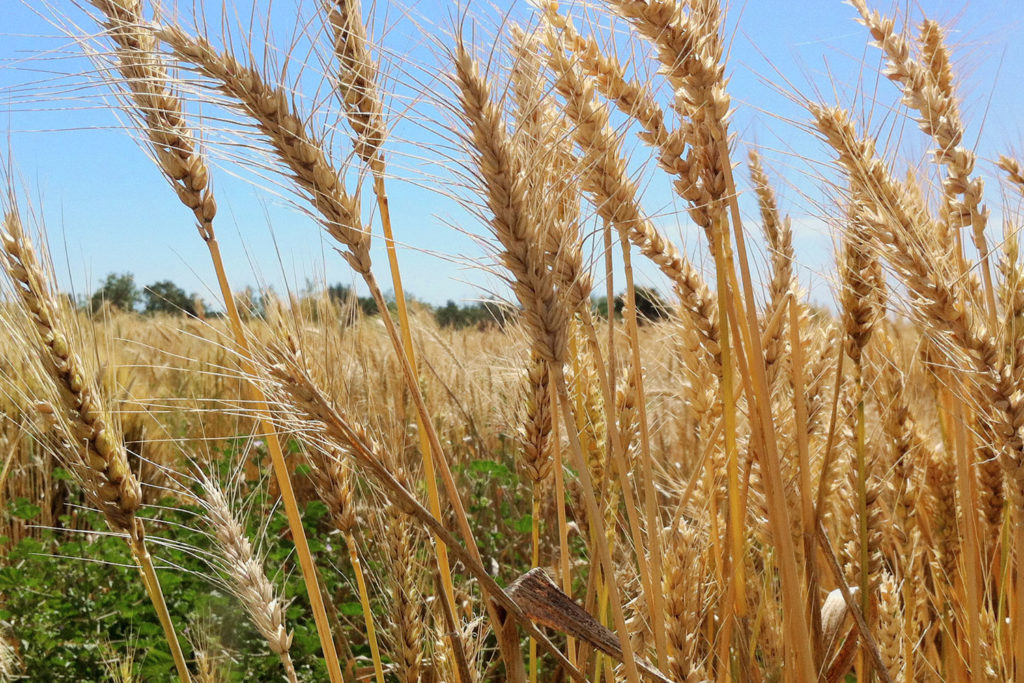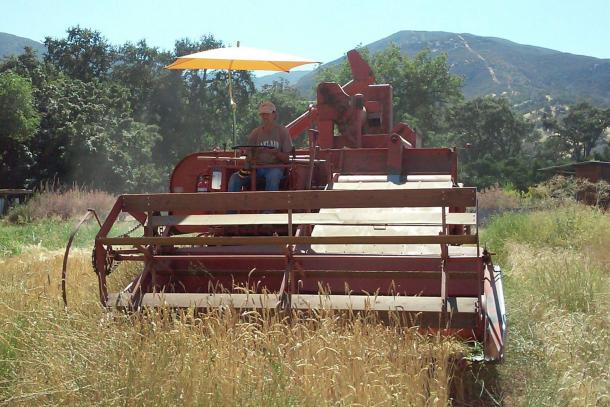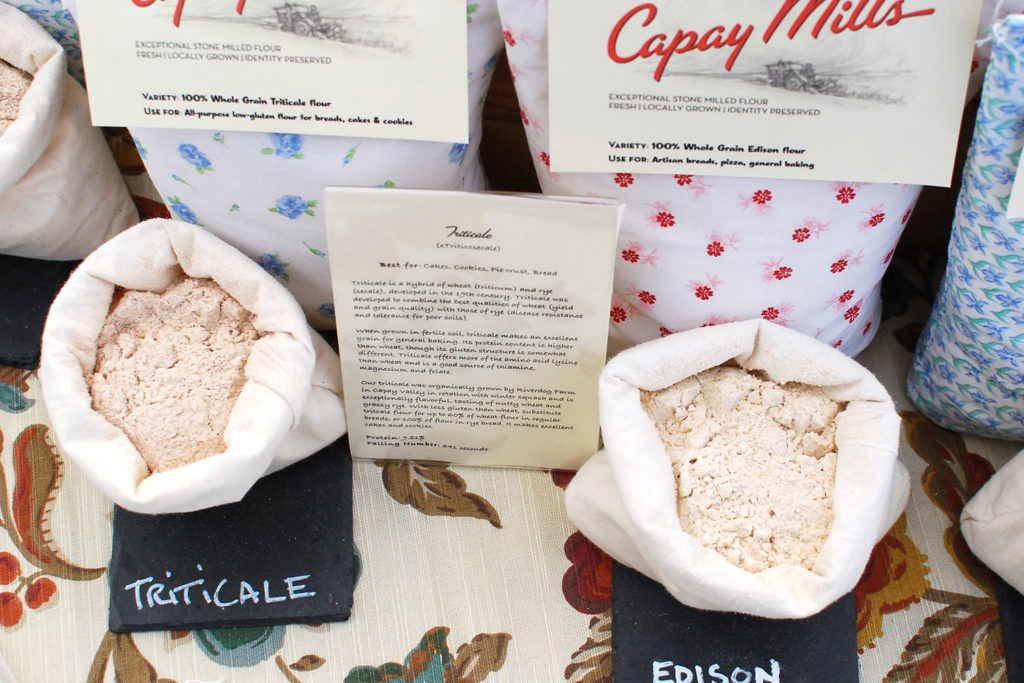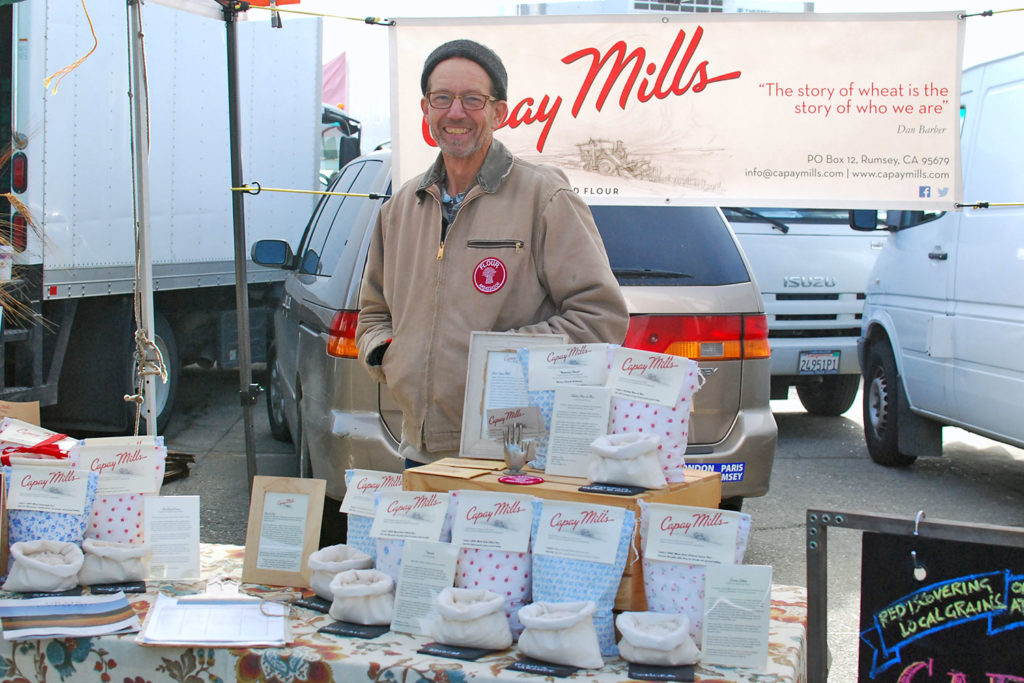A California Grain Revival
September 15, 2017

Conventional white flour gets a bad rap, and rightfully so: it’s devoid of nutrition and flavor, and it’s made from wheat that’s grown in large monocultures and sprayed with industrial pesticides. But flour wasn’t always made that way.
Grain farmer David Kaisel of Capay Mills is part of a countermovement known as the California Grain Campaign, a group of small-scale growers who’ve banded together to increase the availability and diversity of local grains and bring back traditional forms of milling. The result is fresh whole-grain flour that keeps flavor and nutrients intact.
The heirloom grains on David’s 15-acre farm in Capay are largely grown for seed to help farmers plant these lost varieties. His stone-ground flours are also available at the Ferry Plaza Farmers Market, where he educates home and professional bakers on the wild, complex, and delicious world of ancient grains.
Foodwise: What’s wrong with how wheat is produced in the U.S. today?
David Kaisel: It’s kind of the elephant in the room. For all the interest in organic and sustainable agriculture, the focus has been on fruits and vegetables. But grains and cereals represent a larger proportion of agricultural land and our diet. We pay very little for the grains we eat, but the way that we get these incredibly low prices is that grain production is super mechanized and industrialized. Grains are grown at the scale of thousands of acres at a time, which depends on heavy use of inorganic fertilizers, herbicides, and pesticides. The result is that many of the calories in our diet come from a very industrialized process.

Foodwise: How has grain production changed over the last century?
DK: Grain is our original crop. People have grown grains for over 10,000 years. It’s the basis for much of our civilization and social structure. Every farmer used to grow their own grains to feed their family, community, and livestock. Farmers had equipment to harvest and clean the grain on their farm, and oftentimes it was milled locally. Grains were treated like a fresh food product instead of what we have today.
Nowadays there’s little of that infrastructure left for small farmers. With the Green Revolution in the late 1950s and 1960s came the introduction of high-yielding modern wheat varieties, which revolutionized food production worldwide. There was a shift from local, sustainable, small-scale diversified farming to the monocultures we see today. Modern wheats produce more poundage than traditional wheats, but they do so at the cost of having to use a lot of fertilizer and herbicides. There’s a whole chain of consequences that come with the added productivity of modern wheats, which has compromised the quality of the food we’re eating and the sustainability of the farming practices that go into it. The whole system is geared toward producing calories at the lowest cost. And to do that you scale up, and you mechanize everything as much as possible.

Foodwise: How does the way flour is milled impact its flavor and nutrition?
DK: For thousands of years, grain was ground fresh on a stone mill. Stone mills basically keep the bran and the germ intact. The flavor and the nutrition is in the bran and the germ primarily, and in the oils in there. But those oils go rancid quickly. So fresh whole grain flour really doesn’t have much of a shelf life. It starts to lose its oomph after a few weeks.
In the 1850s, roller mills were introduced to help preserve flour so it could be shipped from the Midwest to population centers in the East Coast. Roller mills are efficient at separating the bran and the germ from the starch, and what’s left over is white flour. Because the oils have been taken out, you can put it in a bag and keep it on a shelf for months or years at a time. But you also lose the nutrition and flavor. Today the USDA mandates that white flour has to be fortified with vitamins and minerals.

Foodwise: What’s the California Grain Campaign?
DK: I’m part of a group of growers who are trying to bring back small-scale grain production, working with traditional varieties of grain and milling flour to order. We’re trying to recreate the local grain economy. California used to be the third largest producer of wheat in the country. To this day, we have the largest number of flour mills in the country. The majority of flour in the U.S. is still milled in California, but it’s milled using wheat brought in from other areas.
The campaign is modeled on the Greenmarket Regional Grain Campaign that GrowNYC did in New York. We’re calling for 20 percent of the flour and grain used in prepared foods in farmers markets in California to be locally sourced by 2020. Right now we don’t have enough farmers growing grain to achieve that. So the campaign is about creating, or recreating, this local gran economy from scratch. We’re working to raise awareness among customers, commercial and retail bakers, and restaurants, and working with growers to figure out ways we can produce this grain efficiently enough and at a price that it is accessible.
Foodwise: What are some of the benefits of growing heirloom grains?
Older varieties of wheat grow taller than the modern varieties, which means I don’t need to use herbicides because my 65-year-old combine harvests above the weeds. The older varieties don’t have the same yield as the modern varieties, but I have a lot fewer inputs per acre. Plus, it’s just healthier, not putting chemicals on my fields.

Foodwise: What about benefits to bakers or eaters?
DK: With so many varieties of wheat, there is an incredible range of flavors and performance. It’s no different from grapes, chocolate, coffee, or other foods that have gone from being commodities to sought-after varietal products. I mill 8 to 10 different types of wheat at any time. You can taste the differences when you bake with them. Each variety will produce a unique loaf of bread. It’s like opening up this whole world of new flavors, new textures, and new ingredients. It’s really fun.
What I’m selling is so different from what what’s available in stores. It’s white and it’s fluffy, and that’s about the only thing it has in common. In terms of flavor, nutrition, digestibility, and sustainability, it’s a different product. My customers bring me slices of bread they baked with my flour because it’s so unlike what they’re used to. And once people are aware of what makes locally grown, freshly milled whole-grain flour different, they become really enthusiastic about it.
Find Capay Mills in the front plaza at the Ferry Plaza Farmers Market on Saturdays.
Learn more at the Foodwise Classroom tomorrow at the 10:30 am during our Market to Table Demo with Batter Bakery, using Capay Mills flour.
Grain photos courtesy of Capay Mills.
Topics: Farms
